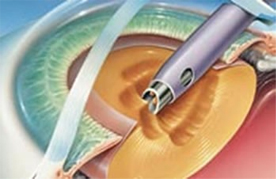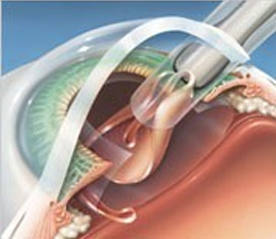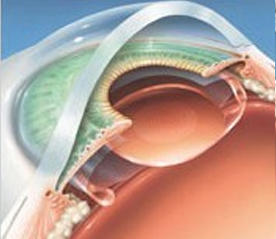Symptoms and Signs
A cataract starts out small and at first has little effect on your vision. You may notice that your vision is blurred a little, like looking through a cloudy piece of glass or viewing an impressionist painting. A cataract may make light from the sun or a lamp seem too bright or glaring. Or you may notice when you drive at night that the oncoming headlights cause more glare than before. Colors may not appear as bright as they once did.
Treatment
In its early stages a simple change in your glasses prescription may be all that is needed to improve vision. However, over time the cataract will continue to grow and eventually cataract surgery will be necessary. Cataract surgery is the only way to improve vision when the cataract has progressed to the point when glasses and contact lenses are no longer beneficial. Cataract surgery is the most commonly performed surgery in the United States. Cataract surgery is usually done on an outpatient basis and involves the removal of the cataract from the eye using a very small incision into the eye. The cataract is removed by using ultrasound energy (phacoemulsification) to break the cataract into small fragments while it is still in the eye. The cataract can then be removed through a very small incision.
After the cataract is removed a new lens must be placed into the eye so the eye can focus normally. This new lens is called a lens implant and it is smaller than a dime. It can be folded into a very small shape and then injected into the eye through a very small incision. Once inside the eye it unfolds into its original shape and then positioned in the center of the pupil. Since the incision into the eye is so small it will usually seal on its own without the need of stitches. Medicated eye drops are then placed on the eye and the patient is discharged home. Recovery from cataract surgery is rapid and patients can resume their normal activities within days. Dr. Teague specializes in cataract surgery. He performs no-stitch, no-patch, no-shot cataract surgery. He uses very potent eye drops to anesthetize the eye making it unnecessary to inject numbing medicine in the eye socket. Consequently, patching the eye after the surgery is not necessary and vision is regained soon after leaving the operating room.
One of the more recent advances in cataract surgery has been the introduction of multifocal lens implants and toric lens implants. Multifocal lens implants allow patients to focus on things up close, far away and in between. Standard lens implants only allow one to focus on things far away. Consequently, glasses must be used to see up close such as reading and using the computer. However, with multifocal lens implants vision is good at all distances and spectacles are usually not necessary. The most recently developed Multifocal lens implant is the Panoptix. Dr. Teague has been implanting this more advanced lens implant since it was approved by the FDA in the fall of 2019. Toric lens implants are used in patients with astigmatism. These lens implants correct the blurred vision associated with astigmatism. We are pleased to offer both types of lenses.

Cataract Removal

Lens Implant Inserted into Eye


